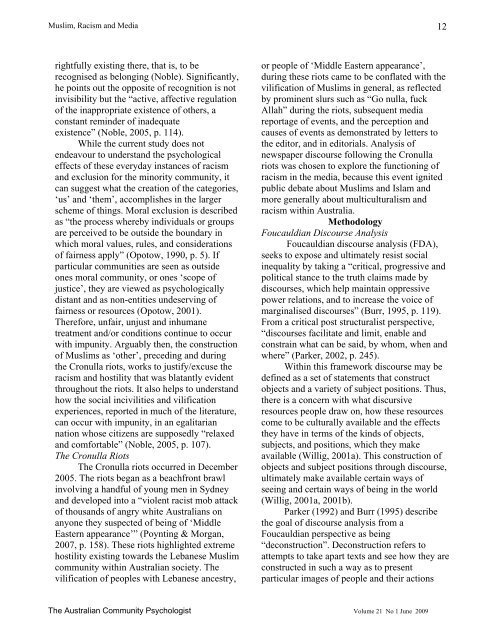issue 1 09 - APS Member Groups - Australian Psychological Society
issue 1 09 - APS Member Groups - Australian Psychological Society
issue 1 09 - APS Member Groups - Australian Psychological Society
Create successful ePaper yourself
Turn your PDF publications into a flip-book with our unique Google optimized e-Paper software.
Muslim, Racism and Media12rightfully existing there, that is, to berecognised as belonging (Noble). Significantly,he points out the opposite of recognition is notinvisibility but the “active, affective regulationof the inappropriate existence of others, aconstant reminder of inadequateexistence” (Noble, 2005, p. 114).While the current study does notendeavour to understand the psychologicaleffects of these everyday instances of racismand exclusion for the minority community, itcan suggest what the creation of the categories,‘us’ and ‘them’, accomplishes in the largerscheme of things. Moral exclusion is describedas “the process whereby individuals or groupsare perceived to be outside the boundary inwhich moral values, rules, and considerationsof fairness apply” (Opotow, 1990, p. 5). Ifparticular communities are seen as outsideones moral community, or ones ‘scope ofjustice’, they are viewed as psychologicallydistant and as non-entities undeserving offairness or resources (Opotow, 2001).Therefore, unfair, unjust and inhumanetreatment and/or conditions continue to occurwith impunity. Arguably then, the constructionof Muslims as ‘other’, preceding and duringthe Cronulla riots, works to justify/excuse theracism and hostility that was blatantly evidentthroughout the riots. It also helps to understandhow the social incivilities and vilificationexperiences, reported in much of the literature,can occur with impunity, in an egalitariannation whose citizens are supposedly “relaxedand comfortable” (Noble, 2005, p. 107).The Cronulla RiotsThe Cronulla riots occurred in December2005. The riots began as a beachfront brawlinvolving a handful of young men in Sydneyand developed into a “violent racist mob attackof thousands of angry white <strong>Australian</strong>s onanyone they suspected of being of ‘MiddleEastern appearance’” (Poynting & Morgan,2007, p. 158). These riots highlighted extremehostility existing towards the Lebanese Muslimcommunity within <strong>Australian</strong> society. Thevilification of peoples with Lebanese ancestry,or people of ‘Middle Eastern appearance’,during these riots came to be conflated with thevilification of Muslims in general, as reflectedby prominent slurs such as “Go nulla, fuckAllah” during the riots, subsequent mediareportage of events, and the perception andcauses of events as demonstrated by letters tothe editor, and in editorials. Analysis ofnewspaper discourse following the Cronullariots was chosen to explore the functioning ofracism in the media, because this event ignitedpublic debate about Muslims and Islam andmore generally about multiculturalism andracism within Australia.MethodologyFoucauldian Discourse AnalysisFoucauldian discourse analysis (FDA),seeks to expose and ultimately resist socialinequality by taking a “critical, progressive andpolitical stance to the truth claims made bydiscourses, which help maintain oppressivepower relations, and to increase the voice ofmarginalised discourses” (Burr, 1995, p. 119).From a critical post structuralist perspective,“discourses facilitate and limit, enable andconstrain what can be said, by whom, when andwhere” (Parker, 2002, p. 245).Within this framework discourse may bedefined as a set of statements that constructobjects and a variety of subject positions. Thus,there is a concern with what discursiveresources people draw on, how these resourcescome to be culturally available and the effectsthey have in terms of the kinds of objects,subjects, and positions, which they makeavailable (Willig, 2001a). This construction ofobjects and subject positions through discourse,ultimately make available certain ways ofseeing and certain ways of being in the world(Willig, 2001a, 2001b).Parker (1992) and Burr (1995) describethe goal of discourse analysis from aFoucauldian perspective as being“deconstruction”. Deconstruction refers toattempts to take apart texts and see how they areconstructed in such a way as to presentparticular images of people and their actionsThe <strong>Australian</strong> Community Psychologist Volume 21 No 1 June 20<strong>09</strong>
















